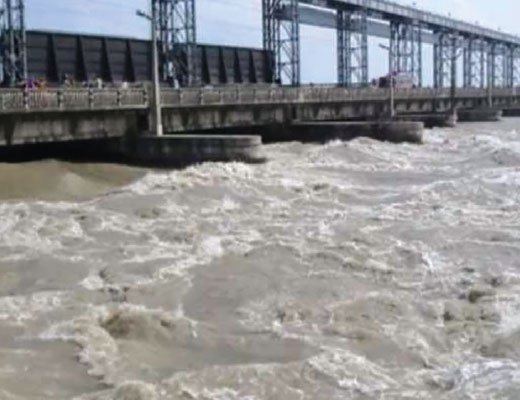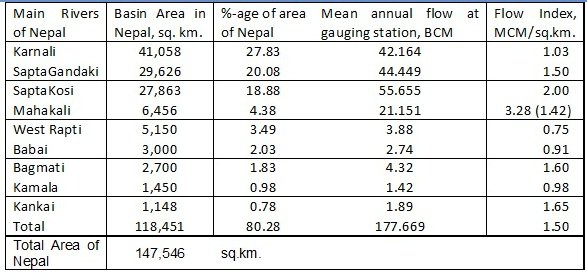
The philosophy of “Rights of Rivers”
The rivers have always been considered sacred by the Sanatan dharma that includes all the sects of Sanatan Dharma or Dhamma such as Hinduism, Jainism, Buddhism, Vaishnavism, etc. All rivers are called “holy mother”, a place higher than the mother herself and therefore they have a special high place in the prayers as well as all religious rituals and practices. It is not possible to trace the date when this practice started but this must have started from a time when the homo sapiens of this region or the Aryans realised the importance of drinking water after every meal and this realisation must have increased with the discovery of agriculture which can be dated back to over 8,000 years in this continent. This importance of river/water has been first included in the Rig Veda, the written form of which is estimated to be between 3,500 and 3,800 years old with its verbal practice continued from time immemorial, in Chapter3, 7 as well as in chapter 10 , , . As the river Ganga and its tributaries in Nepal are referred to as “mother Ganga” in the Vedas and other ancient literature, it is obvious that the practice of worshipping water/river/spring source should have started even earlier than the first step in human civilization that started with the discovery of fire and continued through the domestication of wild animals over 10,000 years ago after the last glacial retreat. The discovery of Neolithic tools at the bank of Vishnumati River in Kathmandu and in Lubhu of Lalitpur also suggests the following three points:
- That the Neolithic tools were made and used by the hunter gatherers in the valley of Kathmandu.
- The hunter gatherer(s) were settled near the river for convenience of fetching water at the same time the river could have provided the hunter gatherer(s) a safer place to hunt the wild animals who appeared by the riverside at certain hour of the day relieving the hunter gatherer the trouble of finding a suitable hunt in the middle of the forest which could put him/them at higher risk.
- They must have started to understand the importance of fresh water for their lives. With this knowledge, the hunter gatherers should have been learning to take further steps into civilization that could have included washing, bathing and cattle rearing and grain harvesting. This must
have led to the major change in their life style from a mobile one for hunting to a limited mobile one for cattle rearing to finally a fixed one required for grain harvesting.
Therefore, the concept of the right of the rivers has started with the human civilization that recognised the importance of rivers/spring sources/water as something most important for life sustainance and therefore all sources of fresh water were considered as sacred places prohibiting any kind of pollution of the water sources as well as water bodies. The whole concept of holy water bodies emerged with the fact of realisation that clean water bodies are important for healthy human lives.
Therefore, as the pioneers of the Rights of the Rivers philosophy as well as the concept that all should be happy quote “ॐ सर्वे भवन्तु सुखिनः, सर्वे सन्तु निरामयाः । सर्वे भद्राणि पश्यन्तु, मा कश्चिद्दुःखभाग्भवेत् । ॐ शान्तिः शान्तिः शान्तिः ॥ Om Sarve Bhavantu Sukhinah, Sarve Santu Nir-Aamayaah, Sarve Bhadraanni Pashyantu, Maa Kashcid-Duhkha-Bhaag-Bhavet, Om Shaantih Shaantih Shaantih” which means May All become Happy, May All be Free from Illness, May All See what is Auspicious, May no one Suffer, Om Peace, Peace, Peace” unquote who recognized the rights of everyone that can include all lives on earth or water to live, prosper and be happy, we should take the leading role in this movement which means practicing such rights and for that practicing to keep the living environment including the aquatic environment unpolluted and pristine not quite ignoring the fact that it all started with the fact that clean water is prerequisite for a healthy living of all the human beings. This notion has been extended to all living beings both flora and fauna in all environments including the blue water bodies both fresh and saline.
This philosophy and we, the followers of such philosophy, therefore, should practice the commitments to keep all the environments as pristine as possible duly recognizing the rights of every stakeholder without any discrimination whatsoever. This, therefore, includes the rights of the rivers of Nepal including all its stakeholders.
Rivers of Nepal
Nepal is home to approximately 6,000 rivers which together drain over 147,546 sq. km. of Nepal including the Kalapani and Limpiyadhura area claimed by India since the late fifties. All rivers of Nepal feed the Ganges either directly or being tributary of the larger rivers. The rivers of Nepal are classified as the first order rivers, second or lower order rivers based on their origin and flow. All rivers of Nepal are predominantly rain-fed. However, the Nepalese rivers contribute about 70% of the total lean season flow and 47% of the total annual flow of Ganga at Farakka. The first order rivers of Nepal, the Koshi, the Gandaki and the Karnali are transboundary rivers that originate in China, cross the great Himalayas into Nepal and continue to flow into India feeding the Ganges. The Ganges flow into Bangladesh and to the sea at the Bay of Bengal. All these transboudary rivers are older than the Great Himalayas.
In between the first and the second order rivers often termed as marginalised rivers lies the Mahakali River which originates at the Limpiyadhura peak in Nepal. It has several names in Nepal and in India as Mahakali, Kali, Kuti Yangdi, Sarda, etc. The entire length of the Mahakali River lies within Nepal even after 1816 treaty of Sugauli when Nepal had to surrender to British India all Nepalese territories lying west of the River Kali and its reference as a border river is totally false: Nepal India border should lie along the western bank of the Mahakali River from its source at Limpiyadhura.
The first order rivers are fed by a large number of perennial as well as seasonal tributaries that originate at the great Himalayas, their glaciers and glacial lakes as well as spring sources in the hills and the mountains of Nepal and China. The second order rivers predominantly fed by monsoon precipitation in the rainy season and by the spring sources during the rest of the year originate in Nepal hills and feed the Ganges either independently or meeting the first order rivers on the way in India. The third order rivers originate farther south. Most of such rivers are live in the monsoon only. Important characteristics of some of the main rivers is as presented in the table below

It is evident from the above table that the largest river of Nepal in terms of total basin area in Nepal is the Karnali River followed by SaptaGandaki (called Gandak in India) River and the SaptaKoshi River. In terms of the total annual flow, the largest river is the SaptaKoshi followed by SaptaGandaki and the Karnali Rivers. However, in terms of the flow index defined as the total volume of annual flow per unit area in MCM per square kilometres, the largest among the first order rivers is the SaptaKoshi followed by SaptaGandaki and the Karnali rivers, whereas the same for the second order rivers is Kankai closely followed by Bagmati and so on. As flow index is the number which actually defines the state of water availability in the basin on the one side and the same can indicate the extent of risk in terms of the water induced disasters, the index should be used with caution.
Status of E-flow, S-flow, H-flow
The dependence of river flow on spring sources especially for the spring fed rivers have been iterated both by the government and the civil society however, appropriate attention to these sources from the perspective of their safety, conservation, protection as well as management from the stakeholders especially from the government has not been seen. Similarly are ignored the importance of the health of the spring sources in terms of water availability for household water supply, irrigation, hydroelectric generation, e-flow, s-flow, h-flows, etc.
E-flow that is understood to include all other riverine water requirements has been considered as 10% of the minimum monthly flow of the river without any rationale and river specific water requirements neither for ecological, environmental, social or other requirement of the river. Social requirement of water is of paramount value as cremations of human bodies are generally carried out by the side of a river and cremation requires free flowing river. E-flow requirement for projects within the protected areas as national parks, wildlife conservation areas, buffer zones, etc. is 50% of the minimum monthly flow and that too without any basis for such requirements. In addition, none of the requirements are followed in practice not even by the Government owned hydropower and Irrigation or other projects on rivers in the lean dry season when the river flow is the minimum.
Rights of Rivers in Nepal
As mentioned hereinabove, rivers and other sources of water and meeting points of two or more rivers have been considered as holy places by Sanatan Dharma and the same has been followed at the grass root level all over Nepal. However, this general principle has been grossly neglected by government policies and therefore, requirements to safeguard the rivers, riverine ecology and sources of rivers including the spring sources and wetlands has been missing in all the actions including permissions and licenses issued by the government to the developers of projects based on river interventions. Therefore, the government of Nepal should formulate plans, policies and actions that support conservation of all blue water bodies including the spring sources, rivers, lakes and other Ramsar areas for rationalising the use of water considering the fact that Nepal is a water stressed country with predominant stress of undersupply for over eight months followed by oversupply in the four monsoon months every year.
Rational use of water bodies should therefore honour the right of each and every stakeholder including the right of local communities living within the impact areas. Rational use of rivers should therefore include effective mitigation measures and should in no way be driven by a particular type of intervention. Such intervention maybe projects on water supply, food production, energy generation, navigation, etc. with or without periodic regulation of water including projects on flood water management as the storage of excess water in wetlands with or without water retaining structures, underground storage of water, etc. For countries like Nepal with tremendous imbalance in water availability in both spatial as well as temporal dimensions, intervention for regulation of water for flow augmentation should form one of the main agenda for the right of the rivers movement if such agenda helps support ecological or environmental conservation of the riverine stakeholders in the lean dry season. Provision of inland navigation seems to help support the rights of the rivers in its totality.
Storage of flood water with small dams in the Himalayan rivers sounds good but is questionable due to high siltation rate and consequent filling of such small storage areas much sooner than as calculated. The concept of “Interlinking of Rivers, ILR” proposed by Ramaswamy Iyer could have components that lie within the limits of rational use of rivers that support the riverine ecology but unfortunately the document, consisting of 17 chapters each authored by renowned experts on the field, prepared by a committee headed by Suresh Prabhu titled Interlinking of Rivers in India: Issues and Concerns, 2008 prepared with the aim of truly guiding the implementation of the ILR in line with the verdict of the Supreme Court of India, failed to justify the tax payers’ monies spent on its preparation as it made mockery of the ILR without actually saying so by not including the management aspect of the project as well as the committee’s concluding remarks leading to its implementation: in part, in full or its cancellation altogether.
Therefore, the rights of the rivers should be redefined to include “Rational Use of River Water” that guarantees that no one benefits at the cost of others: be it riverine ecosystem, the migratory communities including the migratory birds, the communities that live along the river and depend upon it and the entire stakeholders in the downstream areas. This means that the “rational use” of any water body including the rivers should be defined within a framework that can guarantee an unbiased coexistence of all the legitimate stakeholders with voice or without including the communities within and along the river, lake or any other water body irrespective of boundaries local, provincial, national or international.
Examples of extreme irrational use are the water damming structures on the Indian side of the Nepal India border which cause extensive export of floods during the monsoon to the communities on Nepal side due to such Illegitimate Indian interventions. Such demonstrations of enmity in the name of brotherhood should be stopped immediately for the benefit of communities on both sides of the border as well as for honouring the rights of the rivers and their legitimate stakeholders.
Govinda S Pokharel, NWCF. He can be reached at govindaspokharel@gmail.com
References
- Maanavta.com
- Rig Veda, Internet Archive
- Rig Veda Sanhita, Internet Archive
- Edited by Dr. Umesh Puri Gyaneshwar, Charon Ved (in Hindi), Ranadhir Prakashan, Haridwar, India
- RigVedic Arya, 1956, Rahul Sanskritayan (check spelling!!), p-33-34
- Compiled by: C. U. Aitchison B.C.S., Under-secretary to the government of India in the Foreign Department, Volume II, Calcutta 1892, A Collection of Treaties, Engagements and Sanads Relating to India and Neighbouring Countries, Part III, Treaties, Engagements and Sanads Relating to Nepal No. LIV, pp 173-175 and memorandums pp.176-192.

















